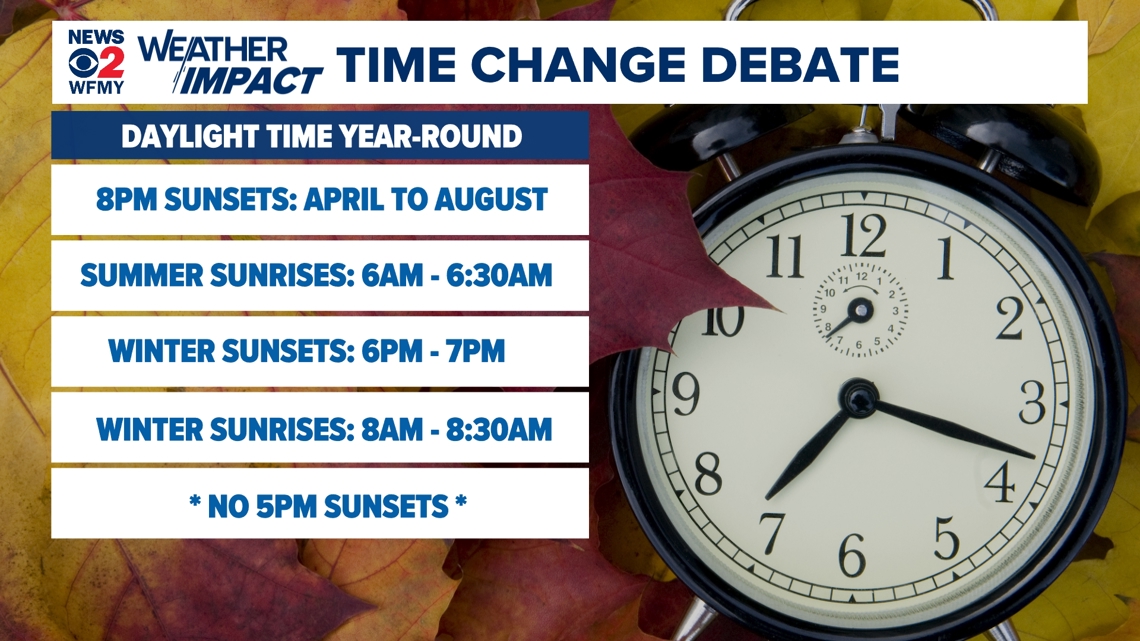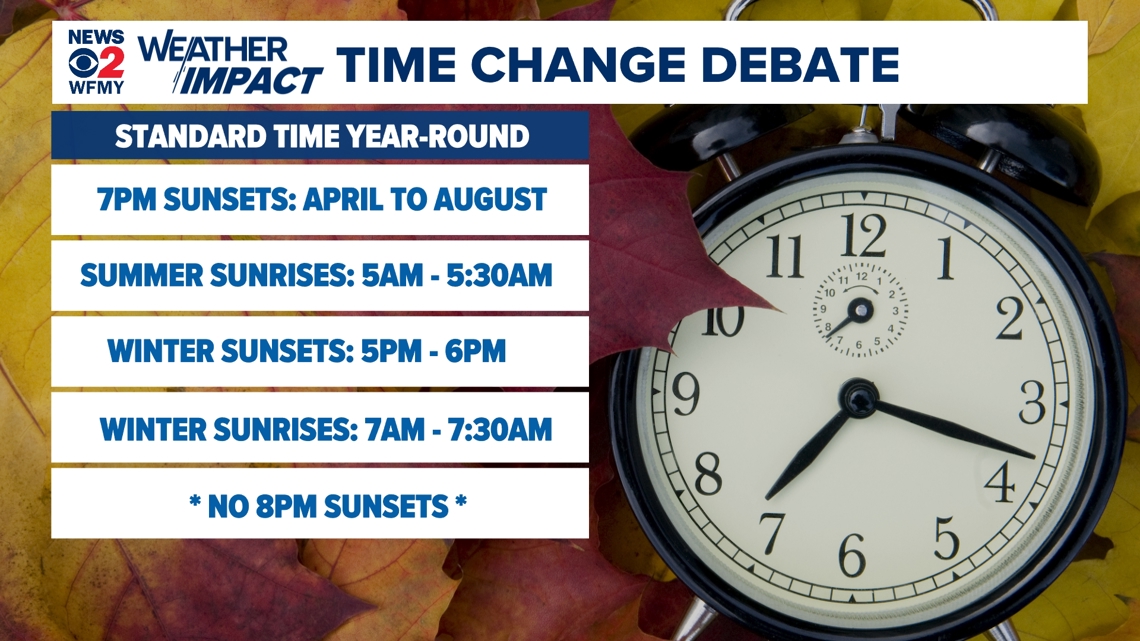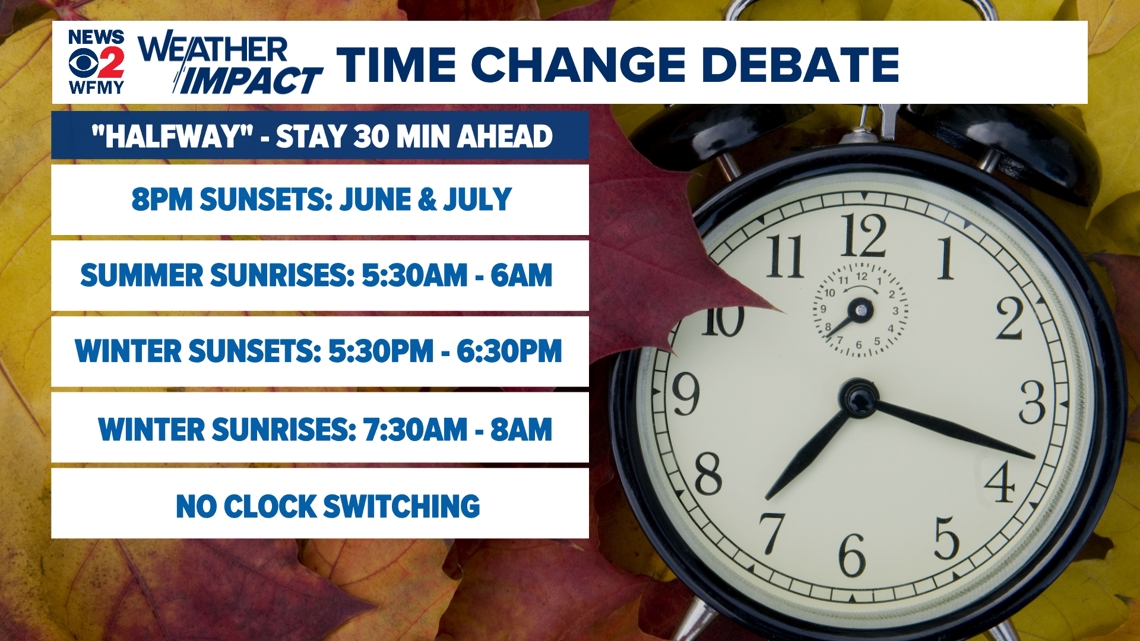GREENSBORO, N.C. — Every year it happens twice: the clocks spring forward, and then the clocks fall back. Whenever we adjust for Daylight Saving Time and then adjust back there's a great debate. Many suggest that we stop changing the clocks, but have you ever actually considered what it would look like if we did that?
It's important to consider the facts before simply saying that we should change the system. There are a few ways the time change could be, well "changed"! One option is to stay on Daylight Time year-round. Another, is to stay on Standard Time year-round. Another proposal would have us adjust by 30 minutes and leave it. Lastly, we could keep the current system the way that it is.
No system is perfect. Daylight can't be created or destroyed. We can't make days longer, we can only shift the time to fit.
Do you know which you would prefer and why? Let's explore those options and what they would mean for our Piedmont area of North Carolina. (Times are specific to Greensboro, NC and will vary by location)
The Current System:
The way it is right now, and has been for most of our lives. We know we have to switch the clocks ahead in the spring, and back in the fall. We get some late sunsets in the summer, but have early sunrises in the winter.
- About 4 months of 8 p.m. sunsets April - August (latest 8:43 p.m.)
- Summer sunrise between 6 - 6:30 a.m. (earliest 6:01 a.m.)
- About 3 months of 5-6 p.m. sunsets (earliest 5:04 p.m.)
- Winter sunrise mostly between 7 - 7:30 a.m.
- Switch clocks forward in spring, and backward in fall


Keeping Daylight Saving Time Year-Round:
If we kept the Daylight Time throughout the year, there would be a few noticeable changes to our daylight. Most notably, our winter sunrises would get very late. As late as 8:30am. On the flip side, winter sunsets wouldn't be quite so early. They'd mostly fall during the 6-7pm hour.
- About 4 months of 8pm sunsets April - August (latest 8:43pm)
- Summer sunrise between 6 - 6:30 am (earliest 6:01am)
- No sunsets in the 5pm hour
- About 3 months of 6-7pm sunsets (earliest 6:04pm)
- Winter sunrise will be very late 8 - 8:30 am time!
It's important to note that Daylight Saving Time isn't our "real" time. It's the adjusted +1 hour mode that we live our summer months in currently. Solar noon is at 1pm under this system.


Keeping Standard Time Year-Round:
If we kept Standard Time throughout the year, you'd really notice the difference in the summer. Our sun would never set after 8 p.m. Instead, summer sunsets would fall in the 7:00 hour. On the flip side, we don't have to worry about changing the clocks in this method and we never have truly late sunrises.
- No 8 p.m. sunsets
- About 4 months of 7 p.m. sunsets April - August (latest 7:43 p.m.)
- Summer sunrise between 5 - 5:30 a.m. (earliest 5:01 a.m.)
- About 3 months of 5-6 p.m. sunsets (earliest 5:04 p.m.)
- Winter sunrise mostly between 7 - 7:30 a.m.


Set the Clocks Ahead 30 Minutes and Leave It:
A more creative option is somewhat of a compromise. If you set the clocks ahead 30 minutes this spring, and then left it that way forever what would it look like? Well, summer sunsets wouldn't be quite as late. Winter sunsets wouldn't be quite as early. The positive would be no need to change the clocks twice per year.
- About 2 months of 8pm sunsets June - July (latest 8:13pm)
- Summer sunrise between 5:30 - 6:00am (earliest 5:31am)
- About 3 months of 5:30pm - 6:30pm sunsets (earliest 5:34pm)
- Winter sunrise 7:30 - 8am time
- No changing of the clocks


So which do you prefer? All the systems have pros and cons. Whatever your opinion, it might not matter much unless something changes in Congress.
Recently the Sunshine Protection Act was proposed which would keep the United States on Daylight Saving Time year-round. It passed the Senate but was never taken up in the House. Remember, this proposal would mean very late winter sunrises for us - as late as 8:30am. The gain would be no 5pm sunsets in the winter.

